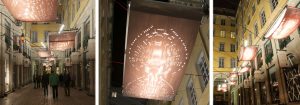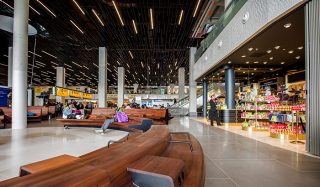A guest post by Sophie Valla
Lighting design can transform the perception of any space. It can render a three-dimensional sculpture, while focusing on restrictive parts of buildings or infrastructure. It can easily be combined with simple structure elements such as textiles or weightless material.
Urban Lighting in Public Spaces

(Image © Marcus Koppen)
Light has always been a part of the urban experience and once represented modernity and progress. While urban lighting focused on retail and security, cities are now promoting more and more lighting design to generate alternative urban experiences in public spaces.
LED Clouds

Last year, we were given the mandate to refurbish two abandoned gas stations at the entrance of the new Noorderpark in Amsterdam North. New light installations turned the derelict buildings into colorful structures.
The light installation under the flat roof is a special feature of the remodeled structures. Sixty textile panels made of the fabrics used in advertising banners were cut to various sizes. Each fabric panel was backlit by LED designs, programmed independently. The 60 fabric panels were combined with colorful spotlights in a giant puzzle, creating a 40x10 meter artificial sky.
The new roof offers a dynamic light animation lasting 30 minutes, and mimics shifting cloudy Dutch skies. Twenty fluctuating skies, inspired by nature but generated with technology, lead us through bright and stormy days from sunrise to sunset. The changing environment creates an artificial sky for the new public square.
Resonanz

Resonanz by Sound and Light Act - Festival of Lights, Kreuzberg, Berlin
Last winter we founded a collective, Sound and Light Act, with Sushelaa Sankaram and Leonard Roussel. Sound and Light Act is a flexible, collaborative network of creative architects, lighting and sound designers.
Together we presented a project in Berlin for the Festival of Lights, Resonanz, in Kreuzberg. Our project was supported by Arup Amsterdam.
Our installation, Resonanz, invited people into the courtyard of the Aufbau Haus, a multifunctional space hosting various cultural institutes and companies. Using light projections on big scale twists made out of textile, choreographed with projected sounds, an inner landscape for the building is created as an immersive environment for the visitors.

The textiles are cut in a pattern reminiscent of musical notation, and suspended in the courtyard to become three-dimensional shapes. They engage the space at all levels, reconfiguring the areas under the existing bridges.
Light and sound are composed in overlapping sequences, in a form representative of a musical canon that varies in intensity, speed, color and density. The light animation generates strong shadows on the ground and reflections in the curtain wall that transform the perception of the strictly defined architecture.
The building is dematerialized as the glass, concrete, and metal surfaces become projection surfaces.
Street Score

Street Score by Sound and Light Act - La Fête des lumières, Lyon, 6th-10th December in Passage Thiaffait
Here we decided not to program any of the light features. Instead we ourselves built screens (a painful mechanical lesson!) that permanently rotate around cylinders, thanks to small motors. The cut out patterns, recalling the silk Jacquard cupboards (created in Lyon) project shadows in movement on the floor.
Light, which is diffused through hanging openwork textiles and combined with a soundscape, plunge you into a world of patterns and sounds in perpetual movement.

I believe that the future of light doesn’t lie exclusively in new technologies but in its use. To create an interesting light installation, it might be more important to react to the specific site and its spatial qualities. I’m also fascinated by simple phenomena, like ‘moiré’ effects, shadow’s generation, movement in front of the light sources… How can one amplify these phenomena and how can one suggest a spatial illusion?
What excites me is the invasion of light in all disciplines, from fashion to medical care.
I hope that infrastructure such as subways or halls for supermarkets will obtain proper lighting, and instead of having a row of oppressive lighting, visitors would get to experience light beams as beautiful as the sun shining through a tree after the rain!


